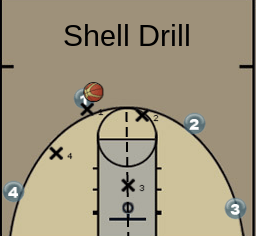Whether a coach forces sideline or middle-or not at all-or plays a soft or hard zone, inevitably defenses are constantly put in help and recover situations. If one attends most any pre-season practice at least at the HS level or higher, one will witness one form or another of a shell drill for basketball with concentration on appropriate slides on ball movement.
Unfortunately, many teams will religiously do this for a week or so and then perhaps refer to the drill occasionally during the season or actually review it once in awhile.
If one were to somehow compute the number of times a team has to help and recover during the course of a season and then compute the number of minutes actually reviewing proper vision, position and technique, the ratio might be a little embarrassing.
One can also witness teams that practice a 5 on 5 shell drill for basketball but never break it down into component 2 and 3 man drills like guard-guard help and recover; forward-guard help and recover etc. Even worse, one can witness teams actually practicing poor vision, poor positioning and late movement.
With all that in mind, let’s review some principles, which are central to most, if not all, systems.
We’re still operating on the premise that “no help” is ideal or “the less help-the better”.
We’re still operating on the premise that, in general, the fewer fouls-the better.
Peripheral vision
At the beginning of any shell drill or any breakdown drill, one MAY witness all players having good peripheral vision. But once the ball is passed (even once) and especially if the ball is dribbled, good constant peripheral vision breaks down. Peripheral vision needs to be practiced. This can start in regularly scheduled shell drills throughout the season-not just a few times in the pre-season. On every pass and every bounce, the goal is to maintain proper vision. A player has to slide WITH peripheral vision. (Most players slide with their heads down and try to re-establish peripheral vision when they get to their new spot). Even the most focused players have a difficult time with this.
Positioning
Wherever a coach wants the four other players off the ball is dependent on a system. However, on every pass and every bounce-all defender positions on the floor change. Again, the most ignored (or least taught) defensive positioning occurs when the ball is dribbled). The defenders off the ball HAVE to move on every bounce because their “best spot” changes whether their man moves or doesn’t. This needs individual drill work for players to really get.
Communication
Some teams during shell drill at basketball practice calling out assignments as players slide like “Ball”, “Deny”, “Help”, “Support” etc. It’s always amusing in the pre-season to hear players holler out loudly “Ball, ball, ball, ball”- multiple times and then 2 weeks later never hear a single word from any player. Hollering for effect is useless but meaningful, consistent talking always helps a defense.
(Thus far, we haven’t included any player exchanges or screens of any kind as those will be incorporated after basic shell vision and positioning is established. Future articles will discuss those).
One way to visualize the ideal shell drill for basketball practice is to picture your 5 players as computerized stickmen attached by visible laser lines. (Bear with me on this). Back in the day, coaches used the rope analogy-all five defenders are attached by ropes. The ideal was and is (whether a rope or laser line) that all 5 players move as one. On one bounce right or left, your stickmen should also move one step right or left. Then picture 2 bounces and so on and so on. Then picture one pass, and your stickmen’s corresponding movements to their “best spots” and then picture the same for each subsequent pass. The “computer” image should show simultaneous replication of movement by all 5 stickmen with uninterrupted peripheral vision.
Now, neither your players nor your opponents are computerized stickmen because they all have different athletic and skill levels. But you can always tweak the “computer” with a scouting report. (The “best spots” obviously change when a very good penetrator has the ball and hasn’t used his dribble.) Also, because your humans aren’t stickmen, you’ll have slippage for various reasons. But if you have an ideal in mind- a simple, basic help and recover plan- and practice it on a consistent basis with shell drills and the necessary breakdown drills to support it, you’ll achieve closer to the model than you otherwise would without the plan.
Read the entire series on Defensive Fundamentals and Teaching Points



